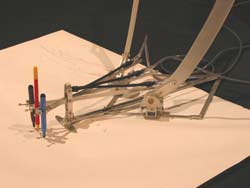Latest News

Columbia researchers divide world according to evolutionary genetics
Monkeys and toads define priority areas for conservation on a fine geographic scale
Scientific determinations of 25 global “hotspots” – habitats with high concentrations of unique species vulnerable to human activity – are too large to be effectively managed by local conservation authorities, much less put aside as protected areas. Researchers from the Center for Environmental Research and Conservation (CERC) are making even finer geographic distinctions within these ’hotspots

New test opens prenatal genetic diagnosis to all
A non-invasive test which allows faster, cheaper, and less risky prenatal genetic screening was announced by Australian researchers at the International Genetics Congress in Melbourne today.
The new test can also be performed much earlier in pregnancy, say its developers Dr Ian Findlay and Mr Darryl Irwin of the Australian Genome Research Facility in Brisbane. It should open the opportunity of prenatal genetic testing to a wider group of women. “This test will focus conventional prenatal te

Wildlife markets and disease transmission
The problem is, pigs and other animals do fly
A consortium of scientists from the New York-based Wildlife Conservation Society announced this week that one way to reduce the risks of future SARS-like diseases is to control wildlife markets. Specifically, markets selling wild animals for their meat not only threaten wildlife populations, but also present a grave threat to humans. A recent example of the problem is the suspected link between wildlife markets in China and the outbreak of

Study results show promise for development of gene therapy to treat blood diseases
Researchers have developed a promising new approach for gene therapy of inherited blood disorders that may help overcome therapeutically limiting human stem cell gene transfer efficiency. This method would be applicable to patients with beta-thalassemia, a potentially life-threatening blood disease, as well as other genetic blood disorders, according to a study published in the July 15th issue of Blood. By transplanting beta-thalassemic mice with stem cells treated with MGMT (methylguanine methyltran

Researchers use lab cultures to create robotic ’semi-living artist’
Working from their university labs in two different corners of the world, U.S. and Australian researchers have created what they call a new class of creative beings, “the semi-living artist” – a picture-drawing robot in Perth, Australia whose movements are controlled by the brain signals of cultured rat cells in Atlanta.
Gripping three colored markers positioned above a white canvas, the robotic drawing arm operates based on the neural activity of a few thousand rat neurons placed in a spec

Scientists uncover amyloid-like proteins in bacteria
Independent research groups have uncovered a new class of proteins, called the chaplins, that function like amyloid fibrils to allow reproductive growth in the bacterium Streptomyces coelicolor. Amyloid proteins are most commonly recognized for their role in Alzheimer’s disease, where they aggregate into insoluble, mesh-like plaques in the brains of Alzheimer’s patients. This finding reveals an unprecedented role for amyloid-like proteins in Gram-positive bacteria.
S. coelicolor i











